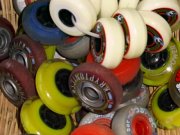|
Home
Inline Skate Resource
Skate Journal
Skate Schedule
Learn To Skate
Skate Accessories
Skate
Links
Article Archives
Where to Skate
Skate Maintenance
Speed Skating
Roller Hockey
Email
Sign-up for Email List
Weather
More Articles From Inline Skate Resource:
Skate Your Butt Off
A Guide to Skating
Hills
OK,
Something is not right here,
my feet hurt when I skate!
Stretches and Warm Ups
for Inline Skating
On The Road Again,
Traveling
with your Inline Skates
When
Should I Replace My Helmet?
Skate Buying Guide
Skate Maintenance
Rocker n' Roll
Inline
Skate Wheels
Buy
Wheels
|
Wheel Elements
Adapted from Tony
Chen’s Article on
“Wheeling Around”

DUROMETER
is the hardness of the wheel. The larger the number, the harder the
wheel. Most recreational skate wheels you will find range from 78 to 82A durometer. Harder
durometers are used more for aggressive skating and go up into the 90s. The harder
the wheel, the longer it lasts, but also the rougher the ride and less grip on the skating
surface.
DIAMETER is the height of the
skate wheel, measured in millimeters (mm). Most wheels are 70mm, 72mm, 76mm, or 80mm, except
aggressive skating wheels, which are in the low 60s and mid 50smm and speed wheels at
100mm. In general, given the same conditions, the taller the wheel, the faster you can
skate.
CORE: The core contains the hub
and spokes of the wheel. The hub is where the bearings and bearing spacer (where the axle
goes through) is. Core are made anywhere from
solid (no spokes) in aggressive wheels, to super-light spoke designs in racing wheels.
PROFILE: is the shape of a wheel
(looking head on)The profile determines how much of the skaters wheel actually makes contact
with the ground while skating.
Comparing Core Types Cores can vary a lot
so choosing wheels based on a core isn’t easy.
Speed skating and racing wheels are comprised mostly of spokes, which
make up most the wheel. This makes a lighter wheel and allows air to pass through to
cool the bearings.
A larger core also means
there is less “wheel” material to wear down. If speed is what you are after then
that shouldn't matter. If longer wear is more important then you don’t want to
go with larger core.
Cores are usually made of nylon type materials,
aluminum, and plastic. In general, there's not too much to worry about
the core. The main exception is if you do lots of jumping then you should look for a
sturdier, smaller core.
Choosing Your Inline Skate Wheel Profile
Inline hockey wheels, recreational wheels, and
speed wheels are somewhat interchangeable. Any of those types of wheels will work for any
of those skating activities. You won't have to swap wheels every time you switch
activities, but you don’t get the best performance for your activity either.
Recreational wheels have average
height, average taper.
Speed wheels are taller, thinner, more
tapered
Hockey wheels are shorter, wider,
rounded.
Aggressive wheels are short, wide,
with a rounded profile and have a solid core

Now it doesn’t matter what profile you get any type of wheel
will wear down past the point of the original profile. Whether you replace your wheels, or
not, is mostly up to you. Unless your in a highly competitive mode, you will find the
profile only makes a small difference, so I'd just use the wheels until they're worn all
the way down.
|
Choosing a Durometer
You don’t have to use the same
durometer on all your inline skate wheels. Some skaters use a mix wheel hardness for a comfortable grip
to the ground and absorption of shock. If you
decide to mix your wheels take a look at the following first.
Wear patterns
Before you rotate your wheels next time, check how your wheels wear.
Do any wheels tend to wear a lot more than the others? If so, you might want to put harder
wheels in their place. I grind down my back wheels more than the others, so I can use a
softer wheel in the front , and harder ones in the back.
-
Durability
and shock-absorption
You may find your wheels wear down faster than you'd like because
you skate outdoors a lot or on rough ground.. You can use all harder wheels, but then you
feel every bump and dimple in the road.
You
can replace half of your wheels with a harder durometer, like half 78A's and half 82A's.
The order that you put them in, isn't really that crucial but to maximize the life of your
wheel remember to check your wear patterns.
-
Skating style
Speed skaters and aggressive skaters are the ones who use mixed
durometers the most. Speed skaters do it for the durability and shock-absorption as we
talked about above. Aggressive skaters often use the anti-rocker setup where the middle
two wheels are very short and hard, and the front and back wheels are tall, to make rail
slides easier.
Diameter
With the wheel diameter there isn't a whole lot to consider. Most recreational
skaters prefer the tallest wheels they can fit on their. Taller wheels means more speed
and the wheels last longer than shorter wheels of the same durometer.
Aggressive
skaters will obviously favor shorter
wheels, possibly even wheels under 60 mm, to give room for grinds and slides, and also to
keep their skates closer to the surface.
|

